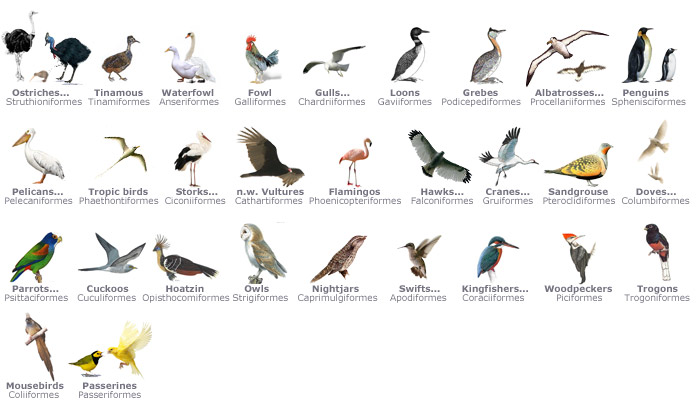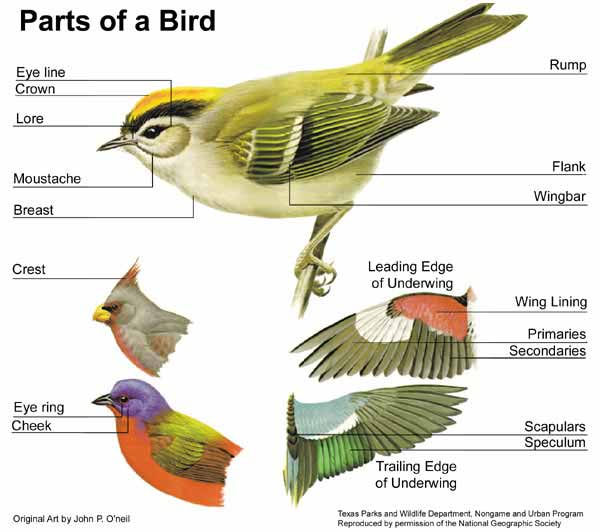Birds Classification Study Guide
Check out awesome, educational VR rooms on Inspirit’s mobile app (available for iOS and Android devices) 🤩
Introduction
The classification of birds is typically based on physiological similarities and genetic makeup, among other features. Birds are warm-blooded vertebrates with a powerful yet lightweight skeleton. They have a four chambered heart, an increased metabolic rate, toothless beaked jaws, wings, and lay hard-shelled eggs. All birds have wings except for two – elephant birds and moa.
Classification of birds
Carlolus Linnaeus was the first to create an organizational framework for classifying species known as Taxonomy. This organization goes from kingdom, to phylum, to class, to order, to family, to genus, to species. We’ll talk about these classifications in relation to birds below.
Bird Taxonomy
Kingdom: The classification of birds is categorized under the animal Reptiles.
Phylum: Further classification of this species falls into the phylum Chordata, meaning that birds fall under the category of animals that have a backbone.
Class: Birds are of the class Aves, meaning birds are warm-blooded vertebrates.
Order: Aves is segregated into 23 bird orders. Birds from the same order have all similar characteristics and features.
-
Orders of birds include Piciformes, Galliformes, Struthioniformes, among others.
-
Most of the class aves belong to the Passeriformes or Passerines orders.
-
Examples: Birds such as woodpeckers and barbets belong to the Piciformes order, guinea fowl and pheasants belong to the Galliformes order, and emu and ostrich belong to the Struthioniformes order.
Family: The birds’ lower classifications are futher classified into families, of which there are approxiimately 142.
- Family is indicated by ending in –dae. For example, the order Apodiformes is segregated into typical swift family Apodidae and crested swift family Hemiprocnidae.
Genus: Families are then classified into a Genus. The class Aves has around 2,057 genus.
Species: The next and final classification of birds is Species. There are between 9,000 and 10,000 species of birds.
Subspecies: Species may further be divided into subspecies due to differences in the same bird species due to geographical impact.
Bionomial Nomenclature
In Binomial Nomenclature, species are given a two-part scientific name based on their taxonomy that denotes their genus and species. The first letter of genus is alway written in uppercase, while the species is always written in lowercase. The genus is always written first, and the entire name is italicized.
Let’s look at an example of the taxonomic classification of the African fish eagle, Haliaeetus vocifer.
- Kingdom – Animalia
- Phylum – Chordata
- Class – Aves
- Order – Ciconiiformes
- Family – Accipitridae
- Genus – Haliaeetus
- Species – Vocifer
Features of Birds
Some of the major features of birds include feathers, beaks, wings, skeletons, and eggs.
Feathers
Feathers are formed of keratin and are very important for flying as well as weather protection and warmth. Some of the female birds attract the male birds for mating through feathers (and vice versa), and Keratin is responsible for the growth of nails and hair in other animals.
Beak
Also called bills, the beak of birds is bony core and is formed by keratin. It assists the birds in crushing or tearing the food in smaller chunks to swallow the same. Birds do not have teeth, and some birds have sharp ridges around the edge of the beak.
Wings
Every bird has wings but does not necessarily fly. Also, the bird’s body is perfectly built for flying with appropriate curves and powerful chest muscles. Some other mammals such as bats and insects such as mosquitoes also have wings and fly.
Skeleton
Most of the birds have lightweight skeletons and hollow bones. The breast bones of the birds are called sternums and are wide, powerful wing muscles and strong attachment points.
Eggs
All birds give birth to their young ones through eggs made out of calcium and have a layer of hardened mucus.
Conclusion
-
With more and more discoveries around the globe, a lot of research is going on on the order of birds.
-
The 9,000-10,000 types or species of birds are arranged in the appropriate taxonomy of kingdom, order, family, genus, and species.
-
The classification of birds helps ornithologists to study the features and habits of birds.
-
Interestingly, some birds do not possess the basic characteristics yet fall into the categories of birds. Such unusual discussions prevail in many classes of animals.
FAQs
1. What level of classification are birds?
- Birds fall under the Linnaean taxonomy, and biologically they are from class Aves.
2. What are the three classifications of birds?
- The three classifications of birds are mentioned below:
- Terrestrial Birds
- Omnivorous birds
- Long Legged bIrds
3. What is the classification of the modern bird?
- There are between 9,000 and 10,000 species of birds. The modern birds are classified into two groups, namely Palaeognathae and Neognathae. The flightless forms of birds fall under palaeognathae while all others fall under the neognathae birds.
4. What category do birds come under?
- Birds belong to the class Aves of Phylum Chordata from the kingdom Animalia.
5. Is a bird a reptile or a mammal?
- Birds are classified as reptiles, or to be precise, avians. The classification of birds as reptiles is that they do not possess hair or fur such as mammals and have similar characteristics as that of reptiles.
6. What are the main groups of birds?
- The birds have the following major groups, namely:
- Aequorlitornithes
- Gruiformes
- Columbaves
- Strisores
- Inopinaves
7. Are birds considered a species?
- Yes, there are more than 10000 species of birds in the world.
8. Is a penguin a bird?
- Penguins are considered birds due to their distinctive wings, skeletons, feathers, eggs, and beaks.
We hope you enjoyed studying this lesson and learned something cool about Bird Classification! Join our Discord community to get any questions you may have answered and to engage with other students just like you! Don’t forget to download our App and check out our awesome VR room for this guide – we promise, it makes studying much more fun 😎
Sources
-
Bird Classification. https://flexbooks.ck12.org/cbook/ck-12-biology-flexbook-2.0/section/12.21/primary/lesson/bird-classification-bio/ Accessed 6 Dec, 2021.
-
Bird Classification. https://www.birds.com/species/classifications/ Accessed 6 Dec, 2021.
-
The List: The 3 Types Of Birds in the World. https://www.adventure-journal.com/2021/06/the-list-the-3-types-of-birds-in-the-world/ Accessed 6 Dec, 2021.


